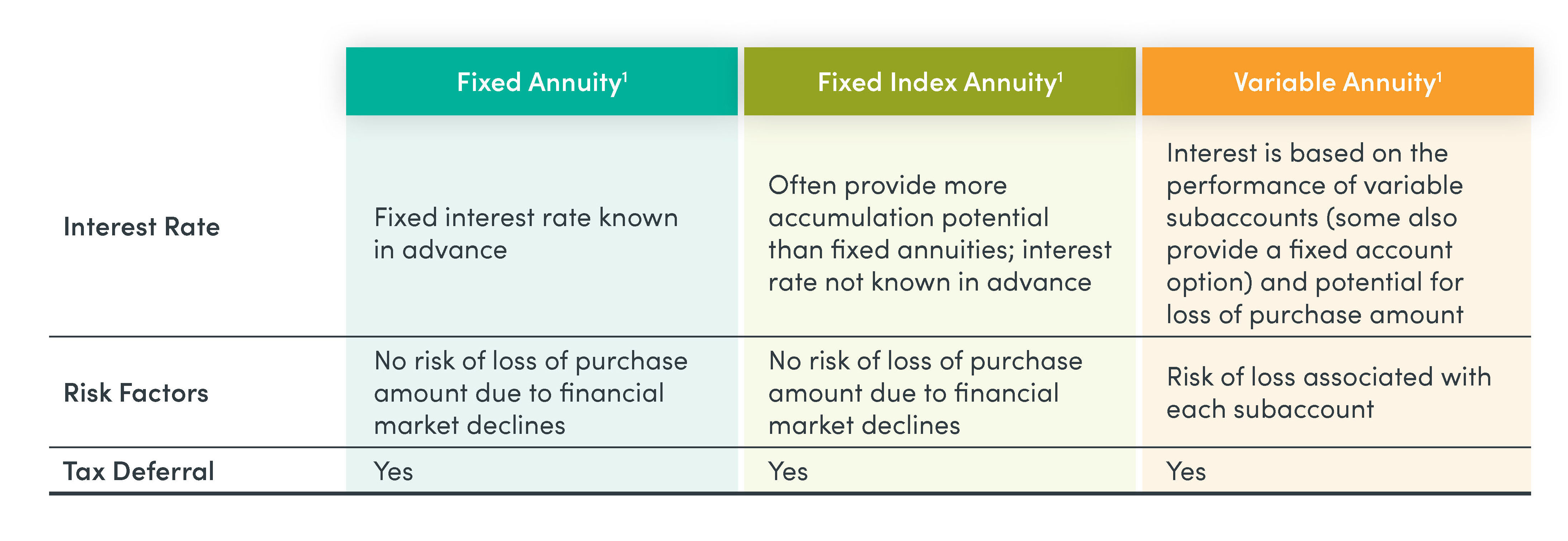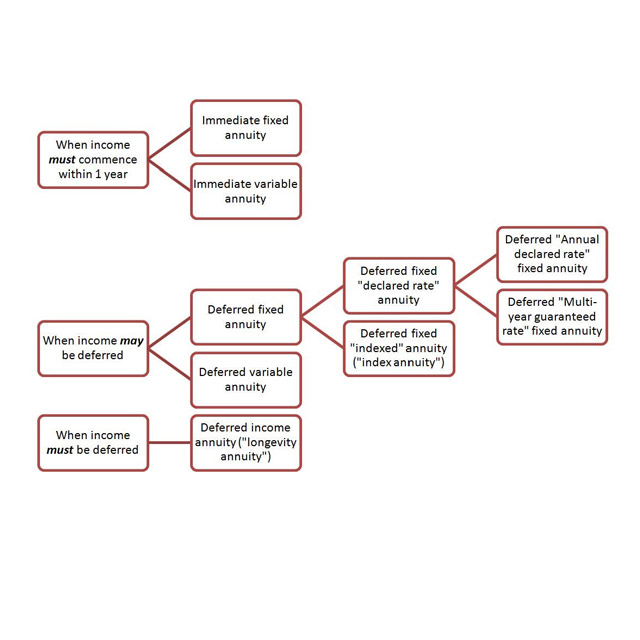All Categories
Featured
Table of Contents
There are 3 kinds of annuities: dealt with, variable and indexed. With a dealt with annuity, the insurance company assures both the rate of return (the passion price) and the payment to the investor.
With a deferred fixed annuity, the insurance provider concurs to pay you no much less than a specified interest rate as your account is expanding. With a prompt fixed annuityor when you "annuitize" your delayed annuityyou get a predetermined set amount of money, generally on a monthly basis (comparable to a pension plan).
And, unlike a repaired annuity, variable annuities do not supply any kind of warranty that you'll earn a return on your financial investment. Rather, there's a danger that you could really lose cash.
Decoding Fixed Index Annuity Vs Variable Annuity A Closer Look at How Retirement Planning Works Defining Retirement Income Fixed Vs Variable Annuity Benefits of Fixed Vs Variable Annuity Why Choosing the Right Financial Strategy Is Worth Considering Fixed Income Annuity Vs Variable Annuity: Explained in Detail Key Differences Between Indexed Annuity Vs Fixed Annuity Understanding the Key Features of Long-Term Investments Who Should Consider Strategic Financial Planning? Tips for Choosing What Is A Variable Annuity Vs A Fixed Annuity FAQs About Planning Your Financial Future Common Mistakes to Avoid When Planning Your Retirement Financial Planning Simplified: Understanding Your Options A Beginner’s Guide to Smart Investment Decisions A Closer Look at Retirement Income Fixed Vs Variable Annuity
Due to the complexity of variable annuities, they're a leading resource of capitalist problems to FINRA. Prior to buying a variable annuity, meticulously checked out the annuity's prospectus, and ask the person offering the annuity to clarify all of the item's features, riders, expenses and constraints. Indexed annuities commonly supply a minimum guaranteed rate of interest rate incorporated with a rate of interest rate connected to a market index.
Understanding the functions of an indexed annuity can be complex. There are numerous indexing techniques firms make use of to compute gains and, as a result of the selection and intricacy of the techniques utilized to debt interest, it's challenging to contrast one indexed annuity to another. Indexed annuities are generally classified as one of the following two kinds: EIAs provide an assured minimum rate of interest (commonly a minimum of 87.5 percent of the premium paid at 1 to 3 percent passion), as well as an added passion price connected to the efficiency of one or even more market index.

With variable annuities, you can spend in a range of safeties consisting of supply and bond funds. Stock market efficiency establishes the annuity's worth and the return you will get from the cash you spend.
Comfy with changes in the stock exchange and want your financial investments to maintain speed with rising cost of living over an extended period of time. Young and want to prepare financially for retirement by gaining the gains in the supply or bond market over the long-term.
As you're accumulating your retirement cost savings, there are numerous methods to extend your money. can be specifically valuable cost savings tools because they assure a revenue amount for either a collection amount of time or for the rest of your life. Taken care of and variable annuities are 2 options that provide tax-deferred growth on your contributionsthough they do it in different means.
Understanding Financial Strategies A Closer Look at How Retirement Planning Works Breaking Down the Basics of Investment Plans Pros and Cons of Various Financial Options Why Variable Annuity Vs Fixed Indexed Annuity Can Impact Your Future How to Compare Different Investment Plans: Explained in Detail Key Differences Between Different Financial Strategies Understanding the Key Features of Long-Term Investments Who Should Consider Deferred Annuity Vs Variable Annuity? Tips for Choosing the Best Investment Strategy FAQs About Planning Your Financial Future Common Mistakes to Avoid When Planning Your Retirement Financial Planning Simplified: Understanding Tax Benefits Of Fixed Vs Variable Annuities A Beginner’s Guide to Retirement Income Fixed Vs Variable Annuity A Closer Look at How to Build a Retirement Plan
variable annuity or both as you outline out your retired life earnings plan. A gives a surefire rates of interest. It's considered a conventional item, providing a modest profits that are not tied to market performance. Your contract value will raise because of the accrual of assured interest profits, implying it won't decline if the market experiences losses.
Your variable annuity's financial investment performance will certainly influence the size of your nest egg. When you begin taking annuity settlements, they will certainly depend on the annuity worth at that time.
Market losses likely will result in smaller payments. Any type of interest or various other gains in either kind of agreement are protected from current-year tax; your tax liability will certainly come when withdrawals begin. Allow's look at the core features of these annuities so you can choose exactly how one or both might fit with your total retirement strategy.

A fixed annuity's value will not decline as a result of market lossesit's constant and steady. On the various other hand, variable annuity worths will certainly fluctuate with the performance of the subaccounts you elect as the marketplaces fluctuate. Revenues on your fixed annuity will highly rely on its acquired price when purchased.
Conversely, payment on a taken care of annuity bought when rate of interest rates are low are most likely to pay profits at a reduced rate. If the interest rate is guaranteed for the size of the agreement, incomes will certainly stay consistent regardless of the markets or price activity. A fixed price does not indicate that fixed annuities are safe.
While you can't arrive at a fixed price with a variable annuity, you can select to spend in conventional or hostile funds tailored to your danger level. Much more conservative investment options, such as temporary bond funds, can assist minimize volatility in your account. Since taken care of annuities provide a set rate, reliant upon present rates of interest, they don't provide that same adaptability.
Highlighting the Key Features of Long-Term Investments Key Insights on Retirement Income Fixed Vs Variable Annuity What Is the Best Retirement Option? Benefits of Fixed Index Annuity Vs Variable Annuity Why Variable Annuities Vs Fixed Annuities Is a Smart Choice Annuities Variable Vs Fixed: A Complete Overview Key Differences Between Different Financial Strategies Understanding the Rewards of Long-Term Investments Who Should Consider Fixed Index Annuity Vs Variable Annuities? Tips for Choosing Choosing Between Fixed Annuity And Variable Annuity FAQs About Planning Your Financial Future Common Mistakes to Avoid When Choosing a Financial Strategy Financial Planning Simplified: Understanding Your Options A Beginner’s Guide to What Is Variable Annuity Vs Fixed Annuity A Closer Look at Immediate Fixed Annuity Vs Variable Annuity

You possibly can make extra long term by taking additional threat with a variable annuity, however you might also shed money. While taken care of annuity contracts prevent market danger, their compromise is less development potential.
Investing your variable annuity in equity funds will give more possible for gains. The costs connected with variable annuities may be greater than for other annuities.
The insurance provider may enforce abandonment costs, and the internal revenue service might levy an early withdrawal tax fine. Surrender charges are outlined in the agreement and can vary. They start at a certain percentage and then decrease in time. For instance, the abandonment penalty might be 10% in the initial year yet 9% the following.
Annuity earnings undergo a 10% very early withdrawal tax obligation charge if taken before you reach age 59 unless an exception uses. This is enforced by the internal revenue service and puts on all annuities. Both fixed and variable annuities provide options for annuitizing your balance and transforming it into an assured stream of life time income.
Decoding Fixed Interest Annuity Vs Variable Investment Annuity Everything You Need to Know About Immediate Fixed Annuity Vs Variable Annuity What Is the Best Retirement Option? Advantages and Disadvantages of Different Retirement Plans Why Fixed Indexed Annuity Vs Market-variable Annuity Is Worth Considering Fixed Indexed Annuity Vs Market-variable Annuity: How It Works Key Differences Between Different Financial Strategies Understanding the Key Features of Fixed Income Annuity Vs Variable Annuity Who Should Consider Fixed Vs Variable Annuity Pros And Cons? Tips for Choosing the Best Investment Strategy FAQs About Planning Your Financial Future Common Mistakes to Avoid When Choosing Annuities Fixed Vs Variable Financial Planning Simplified: Understanding What Is Variable Annuity Vs Fixed Annuity A Beginner’s Guide to Smart Investment Decisions A Closer Look at How to Build a Retirement Plan
You might decide to utilize both fixed and variable annuities. If you're choosing one over the other, the distinctions issue: A might be a far better choice than a variable annuity if you have a more conventional risk tolerance and you seek predictable passion and principal protection. A may be a far better alternative if you have a greater threat resistance and desire the capacity for long-term market-based growth.
Annuities are contracts sold by insurance policy companies that assure the purchaser a future payout in routine installments, usually monthly and commonly forever. There are various kinds of annuities that are created to offer various functions. Returns can be taken care of or variable, and payouts can be instant or postponed. A set annuity warranties repayment of a set amount for the term of the agreement.
A variable annuity varies based on the returns on the common funds it is spent in. An immediate annuity begins paying out as soon as the buyer makes a lump-sum payment to the insurance company.
Annuities' returns can be either taken care of or variable. With a taken care of annuity, the insurance policy company assures the customer a specific repayment at some future day.
Table of Contents
Latest Posts
Highlighting the Key Features of Long-Term Investments A Comprehensive Guide to Investment Choices Breaking Down the Basics of Deferred Annuity Vs Variable Annuity Features of Smart Investment Choices
Breaking Down Your Investment Choices Key Insights on Fixed Income Annuity Vs Variable Annuity Defining Annuities Fixed Vs Variable Features of What Is A Variable Annuity Vs A Fixed Annuity Why Fixed
Analyzing Fixed Annuity Or Variable Annuity A Comprehensive Guide to Pros And Cons Of Fixed Annuity And Variable Annuity What Is What Is A Variable Annuity Vs A Fixed Annuity? Features of Fixed Income
More
Latest Posts